She sent for one of those squat plump little cakes called petites madeleines, which look as though they had been molded in the fluted valve of a scallop shell. And soon, mechanically, weary after a dull day with the prospect of a depressing morrow, I raised to my lips a spoonful of the tea in which I had soaked a morsel of the cake. No sooner had the warm liquid mixed with the crumbs touched my palate than a shudder ran through me and I stopped, intent upon the extraordinary thing that was happening to me. An exquisite pleasure invaded my senses …at once the vicissitudes of life had become indifferent to me, its disasters innocuous, its brevity illusory…
How wonderfully written, isn’t it? This is a translated passage from Remembrance from Things Past, written by Marcel Proust (which of course is in French), which propelled madeleines to worldwide recognition. Proust has been credited with bringing recognition to these plump and full-bellied (with a belly button too!) little cakes, but according to historians, it was King Stanislas Lesczynski of Poland who first discovered it. Madeleines are also known as Madeleine commercy, and they are so known because it is a baked treat found in the Commercy region in France. History has it that in 1730, King Stanislas was in Commercy visiting the Duke, and when it was time to serve desserts, the servants realized that the King's private chef had disappeared without preparing anything for dessert. In desperation, they took some tea cakes that a local maid had made as a replacement, hoping that the King didn't mind. Not only did King Stanislas not mind, he was so pleased with the tea cakes that he demanded to know who made it, and decided to re-name the tea cakes after her, Madeleine.
 |
| Kuih bahulu (picture credits to Tourism Penang) |
I did embellish the tale with more emotive language, but whether the original recount is true or not, we might never know but what we do know is that the madeleine is delicious, and goes especially well with a cup of afternoon tea and a good read! Funny thing is, the madeleine is not as unique as the French would like to think it is - Malaysians have something we like to dunk into our teh/kopi as well - the kuih bahulu! Also known as 鸡蛋糕, these tiny sponge cakes (usually in the shape of a shell or goldfish or a ridged turtle-shell (pardon me but I don't really know how to describe the mould in words - look at the picture on the right) are best eaten when dipped into a hot beverage and eaten after it has soaked up the hot liquid.
Having eaten both madeleines and kuih bahulus, I would say that the latter are more 'crusty' (the hard crispy crust encloses a dry, crumbly interior) whereas madeleines are denser and moister. If made traditionally, kuih bahulu is made using a metal mould, baked over a charcoal fire and only consists of three ingredients: eggs, sugar and self-raising flour (at least my grandma's recipe only has these three ingredients). In comparison, the method of making the madeleine is more time consuming, because you have to let the batter stand for at least 3 hours, or preferably overnight, for it to form the characteristic 'belly button' (this is my own description - the knob-like characteristic is typically called the hump by most bakers).
Kuih bahulu is something I will always associate with Chinese New Year and my grandmother, because when I was younger (and when my grandma had the energy), she would make hundreds of them, and these would greet us when my family went back to our kampong to celebrate the new year. We would dip them into our milo and have them for breakfast, and when it was time to go back to our own homes, my grandma would pack them into containers, and assign each family to one container of kuih bahulu.
Kuih bahulu is something I will always associate with Chinese New Year and my grandmother, because when I was younger (and when my grandma had the energy), she would make hundreds of them, and these would greet us when my family went back to our kampong to celebrate the new year. We would dip them into our milo and have them for breakfast, and when it was time to go back to our own homes, my grandma would pack them into containers, and assign each family to one container of kuih bahulu.
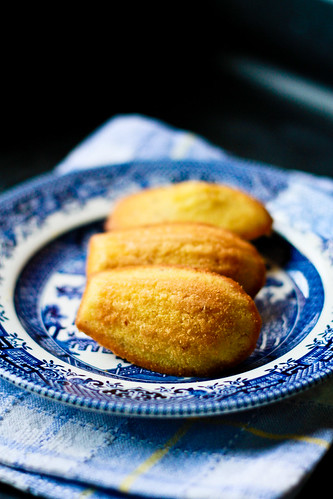 I personally am not too fond of kuih bahulu, because I find it too dry, and I'd much prefer a treat that can be eaten on its own, which is why I'll be baking madeleines for Chinese New Year this year.
I personally am not too fond of kuih bahulu, because I find it too dry, and I'd much prefer a treat that can be eaten on its own, which is why I'll be baking madeleines for Chinese New Year this year. ETA: The host said it didn't fit the requirements of the theme, and so this will not feature as a submission, but it's okay :)
Ingredients
½ tsp lemon zest (from ½ a lemon)
60 g castor sugar
2 eggs (about 50g each)
20ml maple syrup (can be substituted with honey)
½ tsp vanilla extract
80 g all-purpose flour
3 g baking powder
20 g ground almond
¼ tsp salt
100 g unsalted butter, melted and cooled
Method:
- Place the butter in a bowl and microwave it on low for about 30 seconds, or until melted. Let it cool to room temperature.
- Zest half a lemon. In a large mixing bowl, rub the castor sugar and lemon zest together with your fingertips until the sugar is fragrant.
- Add the eggs to the mixing bowl and beat until the mixture turns a light yellow color, or until the sugar dissolves. Do not overbeat.
- Add the maple syrup and vanilla extract.
- In another bowl, whisk together the flour, baking powder, ground almond and salt.
- Gently fold in the dry ingredients into the egg-sugar mixture, making sure all the dry ingredients are moistened (ie, no large lumps).
- Add in the melted butter into the batter and mix until incorporated.
- Cover the batter with plastic wrap and refrigerate for at least 3 hours, or up to 2 days. When ready to bake, grease and flour the madeleine pans (I spray them with non-stick spray, then dust the insides with flour and tap out the excess).
- Remove your batter from the refrigerator and fill the madeleine pans up to 80%.
- Bake them in a preheated oven at 170°C for about 12 - 15 minutes.
Janine’s jots:
- These madeleines are extremely moist, and can be eaten on their own without dunking into your tea or coffee. If you want them to be drier and more crumbly, replace the 20ml of maple syrup with castor sugar instead, because maple syrup (or honey) is extremely hydroscopic, meaning, it absorbs moisture and makes the batter more moist!
- You can use cake flour if you want a finer texture.
- I got my Madeleine pans from Daiso, which means that a pan for 5 madeleines only cost me S$2 =) They are found in the baking section together with other cake pans and they usually run out of stock fairly quickly!
- The ground almonds gave the madeleines a slight 'chew' which I totally loved - if you like a cake with less chew, replace the ground almonds with flour instead.
In pictures:
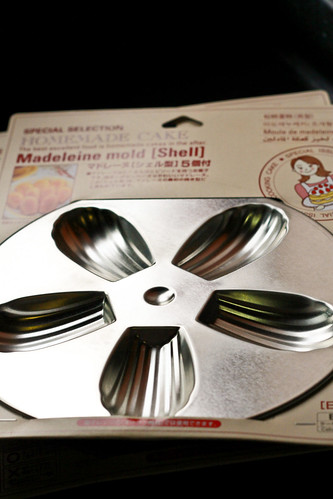 |
| The Madeleine Mold from Daiso - grease and flour them before use! |
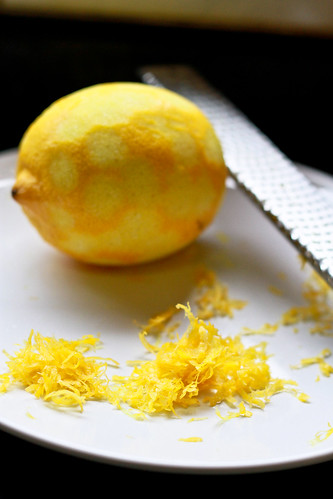 |
| Zest half a lemon for half a teaspoon's worth of zest. Pictured is one teaspoon worth of zest! |
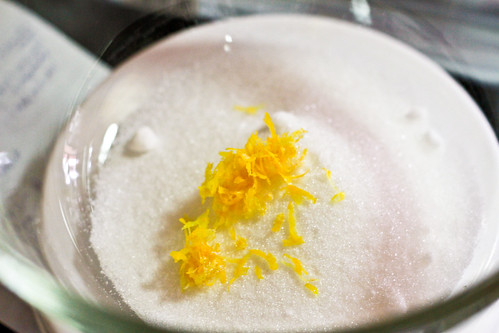 |
| Rub the zest into the sugar with your fingertips. The sugar will become moist and fragrant. |
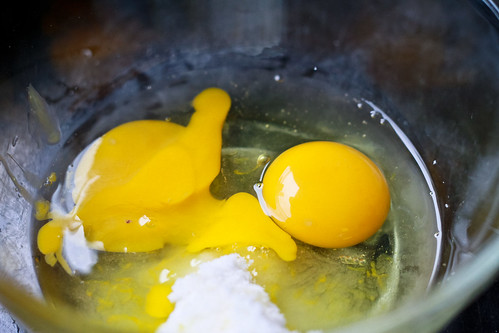 |
| Add the eggs into the bowl and mix until egg is well incorporated and sugar crystals have somewhat dissolved. |
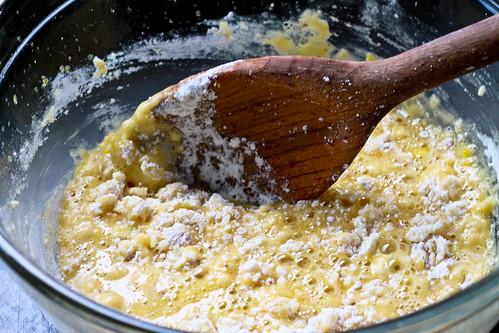 |
| Whisk the flour, baking powder, ground almond and salt into the mixture above. Briefly stir, ensuring no large lumps are left. But do not overstir because you don't want too much gluten to form! |
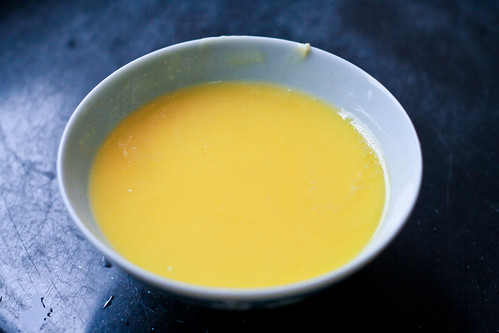 |
| Here's my bowl of melted and cooled butter. It looks like a disproportionate amount of butter to batter, but trust me, it's correct. |
 |
| Add the butter into the batter and give it a quick mix, ensuring it's evenly incorporated into the batter. |


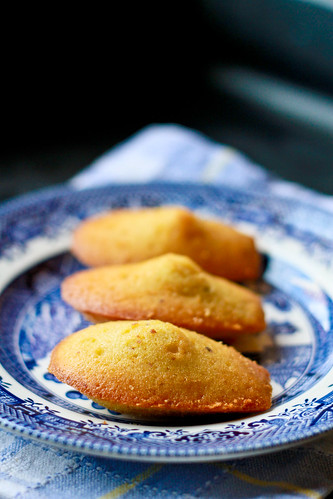
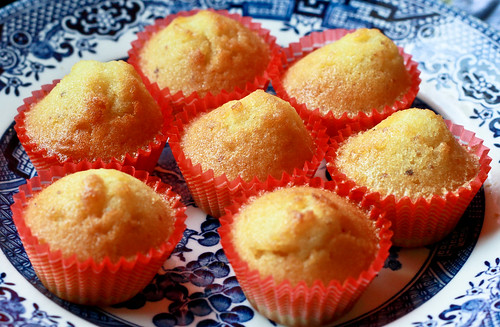
4 comments:
Hello! Beautiful madeleines you'd made there. Did you have problems with them sticking to the moulds? I heard they have a notorious reputation of doing that, despite greasing and dusting the moulds with flour. I'd gotten the Daiso moulds like you did but havent gotten round using them yet. But they are such a steal, duncha think? : )
Wow! I didn't know you could keep this batter overnight...won't the air incorporated be lost after such a long resting? Love your step by step photos, will try it when I have the time:) Thanks!
@travellingfoodies: hey! I didn't have any problems with sticking - I greased them with butter very generously and dusted the flour in - when it comes out of the oven, let them rest in the moulds for a little while before tapping them out? The Daiso pans are kinda 'non-stick' if you know what i mean? Yup they're such a steal that we even got 2 of them! :)
@Jeannie: there's no air incorporated into the batter because you don't really beat the eggs that hard! It's like a cookie batter and the aim is to have a long rest so that the surface bakes faster than the inside and hence when the inside bakes and there's no space to expand, there will be a bump :) Hope this helps! Do try them - they make a really nice dunkable (or not) tea treat!
Wow, kudos! These luscious, jewel-colored images are just gorgeous...I adore madeleines, and made some blood orange and honey ones recently, which made me peer closer at your recipe: I also use a bit of ground almonds or ground hazelnuts, but what I really love is incorporating the nutty taste of browned butter, which I use in place of regular melted butter. Actually I can't remember where I picked that tip up, there are so many madeleine recipes out there...but I am pretty sure I got it from an actual French recipe. Happy cooking!
Post a Comment